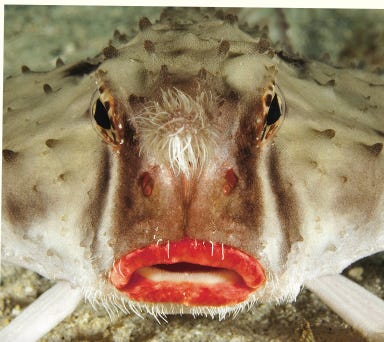Ever met a bird with an umbrella, a salamander called "snot otter," or a fish that wears lipstick? These real-life oddballs from The Screaming Hairy Armadillo are about to spark your students' curiosity in the wildest ways!
Curiosity is the key to unlocking learning, and these quirky creatures are perfect for the job. Below are five Curiosity-Based Thinking (CBT) activities focused on animals with funny, magical, fierce, delicious, and just plain weird names. CBT is all about asking questions, discovering new ideas, reframing perspectives, and creating something fresh.
These activities are designed for grades 1-6. Adapt by simplifying for younger kids with drawing or group work, and adding detail for older students with writing or research. Let's get curious!
🦜 Funny Names: What If...? Wattle Wonders
Animal: Long-Wattled Umbrellabird CBT Strategy: What If...? + Creation
The Long-Wattled Umbrellabird sports a head crest like an umbrella and a wattle that dangles like a goofy necktie—up to 18 inches long!

Activity: Animal Headlines - News from the Canopy
Start by asking: "What if the Long-Wattled Umbrellabird took over your school's morning announcements? What if its wattle could do something wild?"
Instructions:
Brainstorm what news might matter in the rainforest (e.g., "Wattle Watch," weather from the treetops, worm menu)
Have students draw their wattle idea or write a short story about the bird's special power
Create a "broadcast" in the voice of the bird—wattles welcome!
For grades 1-3, focus on pictures; for 4-6, add sentences explaining the wattle's new trick
Optional: Design a rainforest news logo or mascot
Bonus Curiosity Cue: What human tool would this bird invent, thanks to its wattle?
🦔 Magical Names: Fairy Tale Guess
Animal: Pink Fairy Armadillo CBT Strategy: Discovery Learning + Reframing
The Pink Fairy Armadillo sounds like a storybook star with its rosy armor and fluffy fur, but it's real—and tiny!

Activity: Build-a-Burrow - Subterranean Survival Challenge
Instructions:
Show just the name "Pink Fairy Armadillo" and ask: "What do you think this creature looks like? Where does it live?"
Let students draw their guess
Reveal the real critter (a 4-inch burrower from Argentina's sandy plains)
Ask: "What if YOU had to live underground like this little pink digger?"
Have students design their dream burrow or reframe their daily routine to fit underground life
Discuss surprises—did they expect claws or a butt plate?
Bonus Curiosity Cue: What human problems could be solved by "borrowing from burrowing"?
🐉 Fierce Names: Hellbender's Hideout Chat
Animal: Hellbender CBT Strategy: Problem Pizza + Curiosity Q&A
The Hellbender, a slimy salamander with nicknames like "snot otter," lurks under rocks in fast streams.

Activity: Rebranding the Hellbender
Instructions:
Introduce the Hellbender and its PR problem (scary name, low awareness)
Use the Problem Pizza template:
Crust (problem): Low awareness, scary name
Sauce (solution): Rebrand with empathy and science
Cheese (main points): Unique adaptations, endangered status
Toppings (details): Fun facts, new slogans
Ask: "If the Hellbender could talk, what would it say about its rocky home?"
Students create a dialogue or comic strip of the Hellbender bragging about stream life
Grades 1-3 can draw with a caption; 4-6 can write a full conversation
Bonus Curiosity Cue: Why is it Pennsylvania's official state amphibian?
🍳 Delicious Names: Eggcellent Explorer
Animal: Fried Egg Jellyfish CBT Strategy: Biomimicrosity + Discovery Learning
The Fried Egg Jellyfish looks like a sunny-side-up egg floating in the sea—yum, but don't eat it!

Activity: Ocean Energy - Glow with the Flow
Instructions:
Show images of the Fried Egg Jellyfish
Ask: "How did this jellyfish get its eggy name, and how does it survive?"
Students break it down: draw the jellyfish's "egg" shape, then list survival tricks
Challenge them with: "What if you powered your home the way this jellyfish powers its movement?"
Build a model (drawing or physical) of a light or energy system inspired by the jellyfish
Younger kids draw and label; older ones design "field notes" with questions they'd ask as sea scientists
Bonus Curiosity Cue: What if jellyfish had jobs in human cities?
🐠 Just Plain Weird Names: Lip-Smacking A-Z
Animal: Red-Lipped Batfish CBT Strategy: Curiosity A-Z + Creation
The Red-Lipped Batfish struts red lips and walks the seafloor with bat-like fins—talk about weird!

Activity: Underwater Fashion Week - Deep-Sea Style Challenge
Instructions:
Ask: "What if underwater creatures hosted their own fashion show?"
Start with Curiosity A-Z: Create an alphabet list about this fish (e.g., A for "Adorable lips," B for "Bat-shaped")
Grades 1-3 can do 5-10 letters together; 4-6 can aim for the full alphabet
Design the batfish's "runway walk" and describe its look for a fashion magazine
Students draw, describe, or "market" their favorite sea creature looks
Share the wackiest words—who knew fish could be so funky?
Bonus Curiosity Cue: What trends might humans adopt from underwater fashion?

Ready to what your classroom’s curiosity explode with learning? Try these activities and watch your students' imaginations run wild. These exercises are perfect for wrapping up the school year with imagination, insight, and a burning fire to keep learning more!
Stay curious!
Matt
If you’d like to start from the start of this series, here’s the first!
Last Days, Lasting Curiosity: Curiosity Sparks a Wild End to the School Year
The Screaming Hairy Armadillo may sound like pure fun (and it is!) but it’s also a launchpad for something deeper: meaningful, memorable learning fueled by curiosity.
Curious what Curiosity-Based Thinking is?
Curiosity: The Ultimate Classroom Revolution
You're mid-lesson when a student blurts out, "What if we could talk to animals?" Suddenly, your classroom erupts—students debating whale songs, imagining chatty squirrels, and wondering if dogs would spill our secrets. The bell rings, and they're still buzzing with ideas, begging for more time.











Share this post